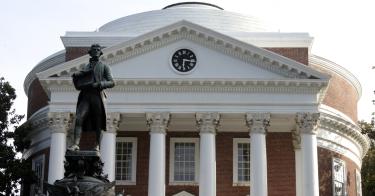Think of it as an academic reflex. When universities face a challenge, their automatic response is to create new positions to address the issue. This at least signals commitment to solving the problem.
But over time, it has contributed to significant bloat in the number of administrative posts on campus.
Hiring people to address problems related to diversity, equity, and inclusion (DEI) has also built an army of political activists who demand that ever more positions be created. Not only has this vicious circle bloated the higher education bureaucracy, it has also strengthened a narrow and divisive vision of racial politics on campus.
Rather than being inclusive to students from all backgrounds—the ostensible goal of DEI—this has made campuses less welcoming.
We recently studied the number of DEI staff at 65 of the nation’s largest universities and found that two of the largest DEI bureaucracies can be found at the University of Virginia and Virginia Tech.
We did not count faculty in ethnic or gender studies departments, whose primary responsibility is in the traditional areas of teaching and research, nor did we count staff required for compliance with federal civil rights legislation. We focused solely on discretionary positions—staff that universities choose to add, often in response to activist complaints.
The University of Virginia has 94 people with formal responsibility for promoting DEI. Only the University of Michigan has more.
To put that in perspective, U.Va. has more than 10 times as many DEI staff as it has staff devoted to providing services to students with disabilities—something universities are required to do by law. There are 6.5 DEI staff for every 100 UVA professors.
Virginia Tech’s DEI bureaucracy is nearly as large. Blacksburg’s 83 DEI staff is 4.6 times larger than its staff providing disability services. It boasts 5.6 DEI staff for every 100 professors.
The titles of these DEI officials is a shuffle of the same words, making it unclear how their responsibilities are not simply being duplicated.
For example, in addition to its “vice president for diversity, equity, inclusion, and community partnerships,” U.Va. also has a “senior director for equity and inclusive excellence” and an “associate dean of students and director, multicultural student services,” each with an assortment of assistants, coordinators, and communication directors.
This university-wide DEI infrastructure is then replicated within almost every college in the university.
U.Va.’s Darden School of Business has an “assistant dean for global diversity, equity, and inclusion” as well as a “senior associate dean & global chief diversity officer.”
The school of law has an “assistant dean for diversity, equity, & belonging,” while the schools of medicine and of nursing each have an “associate dean for diversity and inclusion.”
The College and Graduate School of Arts and Sciences has an “associate dean for diversity, equity and inclusion” along with a paid “director of diversity, equity, & inclusion” in each of its 33 academic departments.
Despite nearly 100 DEI officials with this word-salad of titles, 49 percent of U.Va. students reported in a 2020 survey that they personally experienced or witnessed racial/ethnic harassment or discrimination.
After reviewing a number of student satisfaction surveys, we found that in general, universities with larger DEI staffs did not report better campus climates than at universities with smaller DEI staffs. If anything, the institutions with large DEI staff had worse climates.
None of this should be surprising when we remember that hiring staff is just the way many universities mollify angry constituents. It doesn’t mean the bureaucracies they create are efficiently designed to actually solve problems.
State legislators, boards of trustees, tuition-paying parents, and other stakeholders should demand accountability for these symbolic hiring sprees. They should insist that universities produce evidence of the effectiveness of maintaining an army of DEI staff or cut those headcounts to lower university costs.
We suspect that lower tuition would do far more to promote diversity and inclusion on campus than massive DEI staffs with important-sounding titles.
This piece originally appeared in The Free-Lance Star




